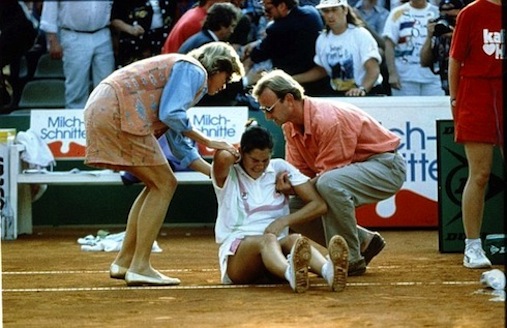1st July, 2015

Jesper Andreassen held up a plate of 10 jalapeños for the camera, then stuffed them into his mouth, one by one, proudly tossing each stem over his shoulder as he finished.
He paused several times to curse, laugh, cough or shout, sounds that devolved into a series of pained growls as he neared the end. Once the last pepper had been consumed, Andreassen, a middle-aged Dane, thanked the viewer for watching. The clip, which Andreassen posted to Facebook in August, had one person as its target audience: Simona Halep, a Romanian tennis player who has been given the nickname Halepeño.
For months, Andreassen had tried to prove his devotion to Halep online, addressing her in a barrage of flattering posts on Twitter. But in April, after seeing a rumour that Halep was planning to marry, Andreassen changed his tone. He became threatening and demeaning, telling Halep that she would die or never walk again for mistreating him.
Halep, who is ranked No. 3 in the world, was playing at a tournament in Stuttgart, Germany, when the threats surfaced, and security officials there were immediately briefed.
Twenty-two years after Monica Seles, the top-ranked women’s player at the time, was stabbed in the back by a Steffi Graf fan during a changeover at a tournament in Hamburg, Germany, many female tennis players say personal security remains an unsettling aspect of life on the professional tour. Officials with the Women’s Tennis Association, the worldwide governing body, say they continue to make the security of tour players their No. 1 concern.
But at the same time, social media has brought players and fans closer than ever, and at times that proximity can be frightening.
That was why, after Andreassen’s threats emerged, security personnel surrounded Halep’s practice session, even though it was held in the morning, before the Stuttgart complex opened to the public.
As she practiced, security personnel looked under seats for suspicious items and even examined empty ball canisters that had been left behind by the last player to use the court.
John Tobias, an agent for several prominent players, including Caroline Wozniacki and Sloane Stephens, said safety concerns were greater for the female players he represented than for his male clients. He said he did not give out the home addresses of his female clients, even to sponsors. When new products come in, they are delivered to the agency’s office and then sent to the player by courier.
“We do little things like that, just if there’s some guy who happened to work in shipping at Babolat,” he said, using Wozniacki’s racket sponsor as an example.
On Sunday, Wozniacki posted a photo on Twitter of one of the new Adidas shoes she had received. On the inside of the shoe was a handwritten note from a man named Andy, who asked her to call him and included a heart drawing and his phone number. “Very creative,” Wozniacki wrote.
Although Wozniacki said she took precautions, she acknowledged a sense of helplessness in a global sport that allows the public close access to its stars nearly every week.

“With social media and with the tournaments being where they are, if someone really wants to find you and really wants do something, you can’t do anything about it,” she said. In the end, she said, “I think you should just enjoy life and do what you want to do, and just hope that people are good out there.”
Pam Shriver, who was president of the WTA when Seles was attacked, said that day was a seminal moment for women’s tennis. “The world totally changed after that,” she said.
Some changes were visible. Players’ chairs were placed farther from the stands, and during changeovers security personnel began standing on the court, facing the crowd. But other changes came in safety seminars given by the tour to its shaken players.
“There were things like, never, ever, in a public setting, say what hotel you’re staying at,” Shriver said. “Never say to a friend across the lobby what room number you’re in. When you go down to work out at the hotel health club, and they ask you what room number you’re in, don’t ever write it down. When you’re a young athlete, you might not consider that. But post-Seles, you did.”
Seles did not return to the sport for more than two years after she was attacked. She never regained her dominance.
Venus Williams said she was always conscious of potentially being targeted. She said she worked on her “first step” to be able to escape dangerous situations. “You have to be aware, and you have to know what’s around you as a player,” Williams said. “If you become any sort of public profile, there’s a chance that there are some people out there who are not as stable as you’d like. And that’s not just tennis; it’s with everything. It’s one of the risks you take.”
Heather Watson, who receives news media attention outpacing her No. 64 ranking as the top woman in tennis-mad Britain, said she had come to accept the abuse she faced online.
“Oh, I’ve had death threats,” Watson said. “I’ve had people threatening to kill me and kill my family, wishing that I get cancer and die a slow, painful death. Horrible words I couldn’t even think up in my head, to be that mean.”
Much of Watson’s abuse comes from aggrieved gamblers after her losses, but other players have had much closer encounters. Halep’s scare in Stuttgart triggered memories for Martina Hingis of the man who stalked her when she was a teenager.
Hingis’s stalker, an Australian named Dubravko Rajcevic, said he was attracted to Hingis, who was 18 at the time, because she resembled his wife, Marina. (Similarly, Andreassen said Halep reminded him of his former wife.)
“He was calling in the hotel rooms and everything, and then the less he could get, the more he was trying,” Hingis said.
Rajcevic knocked on the door of her house in Zurich and attended her matches. Hingis placed the blame for her stunning first-round loss at Wimbledon in 1999 on the stress caused by the realization that her stalker had followed her to England. It was not until the next year, when Rajcevic violated a court order by attending a tournament in Miami in which Hingis was playing, that he was arrested and sentenced to two years in jail.
Hingis’s doubles partner, Sania Mirza, is one of the most prominent female athletes in India, where she is from. She recalled her fear when she discovered that a man she had known to be following her around the world had rented a room on the same floor of her hotel in Thailand.
“It was Valentine’s Day, and when I went back to the hotel room from practice, I had flowers and stuff inside my room,” she said. “It’s scary.”
With the help of the WTA, Mirza filed a complaint and had the man removed from the hotel.
“They’re obviously not normal people, and they’re not thinking straight,” she said. “I haven’t seen him in years now, so that’s fine, but I’ve had a couple experiences like that. It’s just such an uncomfortable feeling, because you feel so unsafe in your own house or in your room. You’re feeling, ‘What’s going to happen?’ Anyone can come and knock on the door.”
While security breaches at tournaments continue, including an incident of a fan approaching Roger Federer on the court at the French Open in May, the most persistent concerns for female players are about their time off the court.
Timea Bacsinszky, a Swiss player who has soared up the rankings over the last 12 months, said she had reported unnervingly persistent harassers to the police. She said her trips out in public in Lausanne, her hometown, were drastically different from those of Stan Wawrinka, the fourth-ranked male player, who also lives in the city.
“If I’m with other girlfriends in a bar, maybe they’re going to come easier because I’m less intimidating,” Bacsinszky said. “Maybe they think I will be nicer or something. I know that it’s easier for them to cross the limit than with a man.”
Several top players mentioned the safety that came with having a male companion in public. Sascha Bajin, the longtime hitting partner of Serena Williams who now works with Victoria Azarenka, said that bodyguard was one of his many jobs with Williams.
“It’s always good to just have somebody by your side, and that’s why she felt comfortable to have me,” said Bajin, an imposing 6-foot-2 Croatian-German.
“She’d always know, ‘There’s Sascha; he’ll have my back.’ ”
Bajin said he soon began accompanying her nearly everywhere she went.
“What if I let her go alone to get her nails done and somebody goes to her and something happens?” he said. “I would be mad at myself. Whenever she would go and get her nails done or do some grocery shopping, you always have that thought in your mind. It’s not even such a crazy thought, because really it can happen. He did try to get into her community.”
Bajin was referring to Patenema Ouedraogo, the man at the center of the most recent major stalking case Williams has endured. Ouedraogo tracked Williams’s movements based on her Twitter posts and tried to enter a Los Angeles office building and a Miami radio station to see her. Ouedraogo, who believed the posts to be messages intended for him, even managed to gain entry to Williams’s dressing room when she visited the Home Shopping Network in Tampa, Fla.
When he appeared at the entrance of her gated community in Palm Beach Gardens, Fla., in May 2011, he was arrested.
In 2002, Williams had another high-profile stalking case, involving a German named Albrecht Stromeyer, who followed her to tournaments and hotels across the United States and Europe before he was eventually arrested outside the gates of Wimbledon.
“I think the WTA, in particular, whenever there was a situation, they don’t wait twice to hear about it,” Williams said. “They take the first step on the initial time.”
Still, Williams has at times employed professional bodyguards while under a specific threat, and she said she had also asked drivers to take her on roundabout routes to keep her from being followed.
Asked to describe her feelings in such moments, Williams grew quiet.
“It’s scary,” she said softly. “Very scary.”
—Culled from The New York Times


